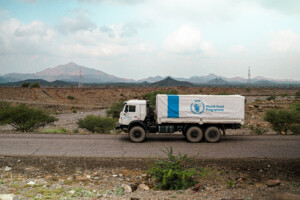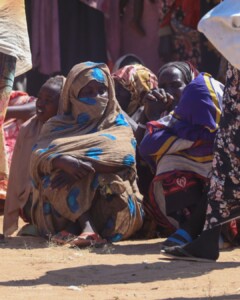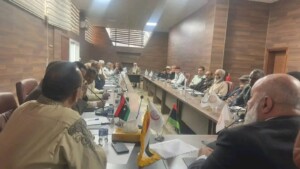Sudan OCHA bulletin 5: About 13,000 people affected by heavy rains
The UN Office for the Coordination of Humanitarian Affairs (OCHA) in Sudan reported in its latest bulletin that heavy rains and flash floods have affected an estimated 13,000 people in Darfur and eastern Sudan.
 A home destroyed by heavy rains and flash floods in Tawila, North Darfur (Fule photo)
A home destroyed by heavy rains and flash floods in Tawila, North Darfur (Fule photo)
The UN Office for the Coordination of Humanitarian Affairs (OCHA) in Sudan reported in its latest bulletin that heavy rains and flash floods have affected an estimated 13,000 people in Darfur and eastern Sudan.
Heavy rains and flash floods affected about 10,250 people in North Darfur’s El Kuma and Tawila localities.
In El Kuma town and surrounding areas, response to the needs of about 4,000 people is ongoing. The World Food Programme (WFP) will support with 15-day rations; the International Organization for Migration (IOM) and the UN Refugee Agency (UNHCR) will provide shelter supplies; health partners are ready to support with a mobile clinic once affected families are relocated to dry areas; the Zakat chamber will also provide assistance; and water, sanitation and hygiene (WASH) partners will construct latrines.
On June 6, flash floods destroyed 470 homes and damaged 397 others in and around El Kuma town, according to IOM and the Sudanese Red Crescent Society (SRCS). The most urgent needs identified were emergency shelter and household supplies, food, as well as health and WASH services.

In Tawila locality, OCHA led an inter-agency mission to camps for the displaced where an estimated 6,200 people (1,243 families) were affected by floods. Partners have been responding to humanitarian needs of people affected and families living in low lying areas in Rwanda camp and its extension Burgo, will be relocated.
There are fears that the inundated lands (ponds and swamps), poor drainage systems, and collapsed latrines will increase the risk of the spread of water-borne infections and diseases. As a precaution, mosquito nets treated with insecticide will be distributed to families affected.
People whose homes were destroyed will receive emergency shelter and household supplies while those whose homes were damaged will receive household supplies. Partners will also distribute food, rehabilitate drainage systems and provided health services.
Heavy rains and flash floods between 3 and 7 June destroyed 485 homes and 899 latrines, and damaged 758 homes. Some people lost all their possessions and food stocks.
Tawila locality has five camps, Rwanda, Dali and Argo, Dabanaira and Burgo (an extension of Rwanda camp), which combined host just over 90,000 displaced Darfuris.
Heavy rains and strong winds damaged homes, schools and the health centre in Leiba village in East Jebel Marra locality, South Darfur, on 8 June, affecting about 325 people. Partners are assisting the 65 families whose homes—built from local materials such as sticks and thatches—were destroyed leaving them vulnerable to the elements. The people lost all their food, possessions and seed stocks.
IOM distributed improved shelters and household supplies to the families whose homes were destroyed and partial household supplies (plastic sheet, jerrycans and a blanket) to people whose homes were damaged; the UN Population Fund (UNFPA) distributed 200 hygiene kits; and WFP distributed food to the families whose homes were destroyed. The World Health Organization (WHO) provided two rapid response kits to cover the health needs of 6,000 people for three months; repaired the solar system used to run cold chain system—which is needed to ensure that vaccines and medicines are maintained at their recommended low storage and handling temperatures at all times—for immunization (EPI) activities; provided chlorine and water quality testing kits; and organized sessions on hygiene promotion and water-borne diseases.
Most of the inhabitants of Leiba village are returnees—506 families (about 2,500 people) and a few IDPs.
Heavy rains and a light earthquake hit Babanousa village on 24 June, affecting 525 people. According to the Sudanese Red Crescent Society (SRCS) state authorities will provide the required assistance.
ICRC distributes food, seeds and tools to 138,000 people facing food insecurity in Darfur
The International Committee of the Red Cross (ICRC) and the Sudanese Red Crescent Society (SRCS) distributed seeds, tools and food to 138,000 people facing food insecurity in North, South and Central Darfur.
"These families who depend on ICRC distributes seeds and tools to vulnerable people in South Darfur (ICRC, 2019) farming are among the most vulnerable in Darfur and do not have enough food to get them through the lean season. The food we are providing is meant to help farmers in the short-term, but our goal is to ensure that they undertake agricultural production and sustain it, so they can gradually rebuild their livelihoods," said Kedir Awol Omar, Head of the ICRC Delegation in Sudan.
More than 475 metric tons of seeds, which include sorghum, groundnuts, cowpeas, sesame, fava beans, tomato, eggplant, okra, onion and watermelon, were distributed to farmers—following consultations with the Ministry of Agriculture—along with farming tools like donkey ploughs.
In addition, ICRC and the Ministry of Animal Resources (MoAR) began vaccinating livestock against common diseases, with the goal of immunizing a total of 800,000 animals. The programme, re-launched for the first time since 2013, will run for the next three years and has started in North Darfur targeting 300,000 animals, after which it will be extended to Central Darfur, South Darfur and West Kordofan states.
The ICRC continues to respond to humanitarian needs in Sudan. Last year, it delivered safe drinking water to around 49,000 persons in Darfur, South Kordofan and Blue Nile, and provided seeds and farming tools to 108,000 people in North and Central Darfur.

Food security continues to deteriorate in many areas of Sudan
During the June to September lean season in Sudan, food security outcomes are expected to further deteriorate and crisis (IPC Phase 3)—when people have food consumption gaps that are reflected by high or above-usual acute malnutrition rates—is expected in parts of Red Sea, Kassala, Gedaref, Blue Nile, West Kordofan, North Kordofan, South Kordofan, and Greater Darfur, according to the FEWS NET Food Security Outlook for June 2019 to January 2020 report. Of highest concern are the displaced people living in areas controlled by the Sudan People’s Liberation Movement – North (SPLM-N) in South Kordofan and areas controlled by the Sudan People’s Liberation Movement-Abdelwahid El Nur (SPLA-AW) faction in the Jebel Marra area, where emergency (IPC Phase 4) levels of food security—when people have large food consumption gaps which are reflected in very high acute malnutrition and excess mortality—are likely during the peak of the lean season from August to September. The harvest from October to January will increase the availability of cereals thus likely improving food security.
Despite this, current macroeconomic conditions are expected to persist increasing prices of food and non-food items and resulting in poor purchasing power. It is anticipated that a higher number of households will face crisis (IPC Phase 3) or worse levels of insecurity through January 2020.
The forecasted above-average June to September 2019 main rainy season has begun in some parts in eastern and western Sudan. Preparations for the 2019/2020 agricultural season are underway in most semi-mechanized and irrigated agricultural areas. Shortages of diesel fuel and other agricultural supplies have been reported in some of these areas. Although this will impact cultivation, the overall area planted is expected to be only slightly below average due to the likelihood of government assistance with diesel fuel and agricultural supplies, as well as households’ sacrificing other purchases to buy agricultural supplies. These factors, coupled with favourable yields, are currently expected to lead to an average production, although production estimates can be made with greater confidence in the coming months as planting is fully underway.











 and then
and then